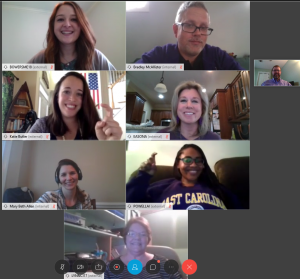April 13, 2020
There are ways to offset worries of teleworking, #LFH
 More than 3,000 College of Business students came back from spring break to a different learning environment. Yes, the College of Business has embraced online learning delivery for 20 years, but that mostly was geared toward graduate students and a handful of undergraduate classes.
More than 3,000 College of Business students came back from spring break to a different learning environment. Yes, the College of Business has embraced online learning delivery for 20 years, but that mostly was geared toward graduate students and a handful of undergraduate classes.
Thanks to Canvas, the College’s new learning management system, professors are now able to add video and audio feedback to graded assignments. “This (Canvas) is a wonderful opportunity to provide additional clarity to students because it offers much more than simple text,” said Dr. Kent Alipour, assistant professor of management in the College of Business.
Alipour’s research focuses on leadership and teams. He especially looks at the environment or situation in which individuals and teams function. Below, Alipour discusses management in today’s new #WFH environments, why interaction is generally the best approach and how today’s technology can offset many worries when it comes to both teleworking and learning from home.
A new work environment
From a management standpoint, one of my biggest concerns is the increased likelihood of communication problems that are likely to arise from the new work environment. For instance, when teleworking, it’s not as easy to quickly walk over to your boss’s office and ask a clarifying question, if necessary. Instead, messages are more likely to be sent through email and text messages, and this may not always be the best channel of communication. For simple issues, it’s fine. However, for issues that lack simplicity, the likelihood of miscommunication could increase.
To clarify, research shows face-to-face contact is superior for complex and delicate issues. When communicating electronically (e.g., email, text message), we are more likely to be misunderstood. Also, we are more likely to be perceived as cold, arrogant, or insensitive. Why is this the case? Well, simply put, face-to-face communication cues are absent (e.g., facial expressions, body language, tone of voice).
This ties into the importance of nonverbal behaviors (i.e., messages that get sent through our face and body language). Typically, we look for nonverbal cues to further understand a spoken message, and in many cases, we are not even aware that we are doing this. Studies have shown that nonverbal behaviors often have a larger effect on others than the actual message itself (i.e., it’s not what we say, but how we say it). Additionally, when there are discrepancies between verbal and nonverbal communications, nonverbal cues are often given more weight. However, this cannot be done if we lack nonverbals to interpret!

A team of ECUCOB RMI students went from a face-to-face to a learning-from-home environment to produce research for Verisk.
Research also shows us that people are more cooperative with each other when interacting face-to-face as opposed to over the phone. Agreements are more likely to be reached, and negotiations are less likely to stall. This cooperation is relevant because supervisors and subordinates often negotiate with each other regularly (e.g., about how to accomplish tasks, how tasks should be prioritized, how schedules can be made more flexible).
When negotiating online, individuals have been found to trust each other less and have less overall satisfaction, especially in the early stages of a relationship (e.g., if you were recently hired before the lockdown, you just got a new boss).
From an ethics standpoint, research also shows us that the likelihood of being lied to increases when interacting and negotiating via email as opposed to face-to-face. Further, individuals often exhibit more inappropriate social behavior when interacting electronically compared to face-to-face. Specifically, research has shown us that individuals are eight times more likely to engage in rude and impulsive communication behavior via electronic communications.
Pursuing this idea further, negative feedback is more common when using email. This research was done on performance evaluations, a routine responsibility for most managers. Specifically, when managers do performance evaluations via email, they tend to display more negative feedback. We know that negative feedback is more likely to stir up negative emotions in subordinates. Why is this relevant?
It’s relevant because negative emotions tend to drain energy and decrease performance. There is a plethora of research on the topic, and these outcomes (i.e., reduced energy, decreased performance) are likely the opposite of what managers want.
Thus, for managers and their subordinates who may currently be teleworking, communication adjustments may be needed to enhance clarity. So how do we deal with this?
Adjusting communications
We should consider using channels of communication that allow us to interact face-to-face (e.g., video conferencing software like Skype, Zoom, WebEx). In turn, we can express and interpret nonverbal behaviors, and reap some of the face-to-face benefits that would otherwise be missing. These channels will also more easily allow for some very effective communication tactics (e.g., schmoozing, active listening).
For example, research shows that schmoozing (off-task or relationship-focused conversations that help to build rapport) increases liking and relationship quality, and ultimately increases one’s potential to shape the behavior of others.
Additionally, active listening (the skill of understanding what another person is saying and feeling, and summarizing to that person, in your own words, what you think he/she is saying and feeling) requires that we understand the emotions of others. That is, we look for environmental cues (body language, tone of voice) to identify others’ emotions. By doing this (i.e., understanding how someone is feeling), we can more easily show them empathy.
Why else is active listening important? Research shows us that it helps to build and maintain relationships, in addition to helping us to gather and understand information more easily. Perhaps more importantly, we know that people generally want to feel valued. And when people feel that they’ve been heard, their liking, trust and commitment to that person increases.
Taken together, face-to-face communication channels allow for these specific communication tactics (i.e., active listening, schmoozing), among others, which can have very desirable benefits for both managers and their subordinates. This includes effective teamwork.
 Dr. Kent K. Alipour is an assistant professor of management at ECU’s College of Business and Department of Management. He earned his doctorate in Industrial/Organizational Psychology, with a specialization in organizational behavior and organizational research methods, from Penn State University.
Dr. Kent K. Alipour is an assistant professor of management at ECU’s College of Business and Department of Management. He earned his doctorate in Industrial/Organizational Psychology, with a specialization in organizational behavior and organizational research methods, from Penn State University.
- Categories:
- Academic
- Management

